Overview
In Queensland, state government-owned corporations generate, transmit, and distribute most of the state’s electricity. They work to ensure affordable and reliable supply against the backdrop of fluctuating demand on the power grid, shifting coal and gas prices, and the supply of renewable energy sources. The Queensland Government has also recently released a $62 billion energy and jobs plan that aims to provide cleaner and more affordable energy.
Tabled 9 December 2022.

Report on a page
This report summarises the audit results of Queensland’s 6 energy entities. These entities generate (CleanCo, CS Energy, and Stanwell), transmit (Powerlink), and distribute (Energy Queensland) most of Queensland’s electricity; and Ergon Energy Queensland is the electricity retailer for most customers in regional Queensland.
Financial statements are reliable
The financial statements of the energy entities are reliable and comply with relevant reporting requirements. All energy entities met their legislative deadlines for signing their financial statements, despite the ongoing challenges presented by the COVID-19 pandemic and the volatility in the energy market.
Weaknesses in the security of information systems
The energy entities have resolved a number of deficiencies identified in prior years. However, we continue to identify weaknesses in the entities’ information systems, mainly relating to how they assign and monitor user access, and in the upgrades to their information systems. During the year, a cyber security incident disabled one of the energy entity’s corporate networks. The entity deployed its business continuity plan and continued to safely generate and dispatch electricity. We carried out additional audit procedures to verify the completeness and accuracy of the data in the finance system once it was restored.
Energy entities rely heavily on information systems for their operations. Recent cyber attacks on the information systems of large Australian corporate entities have resulted in disruptions to their operations and leaked customer data. It is critical for energy entities to establish stronger controls to continue protecting their sensitive information from unauthorised users and cyber criminals.
Sector profits have decreased
The energy sector’s total profits have decreased by $147 million from 2020–21, which is largely due to losses incurred by generators.
During the financial year, average wholesale electricity prices in Queensland increased by 162 per cent from prior year. This increase was due to higher coal and gas prices, increased demand, lower supply of electricity due to outages (both planned and unplanned), and periods of lower output from renewable energy sources.
The generation entities incurred losses on fixed electricity supply contracts because of the volatility in the energy market, but the retail entities recognised gains.
Future challenges and the Queensland energy plan
Extreme weather conditions continue to cause fluctuations in electricity demand, contributing to upward pressure on wholesale market prices. Entities face challenges in balancing the unpredictable supply of renewable energy such as solar and wind, with delivering stable and reliable electricity supply at affordable prices.
On 28 September 2022, the Queensland Government released a $62 billion energy and jobs plan that aims to provide cleaner and more affordable energy, while committing to a 70 per cent renewable energy target by 2032, and 80 per cent by 2035.
Implementation of this plan will lead to significant investment in renewable energy, storage, and transmission in Queensland. Entities will need to consider the impact of current market conditions on the budgets and timing of these projects.

Recommendation for entities
Status of recommendation made in Energy 2021
(Report 7: 2021–22)
Energy entities have been taking appropriate action to address the recommendation we made in Energy 2021 (Report 7: 2021–22). However, we continue to identify significant weaknesses in the security of information systems. All entities must emphasise the importance of strong security practices to protect against fraud or error, cyber attacks, and significant reputational damage. This remains a recommendation for energy entities in 2022.
Appendix C includes the full recommendation and status.
Reference to comments
In accordance with s.64 of the Auditor-General Act 2009, we provided a copy of this report to relevant entities. In reaching our conclusions, we considered their views and represented them to the extent we deemed relevant and warranted. Any formal responses from the entities are included in Appendix A.

1. Overview of entities in this sector
In Queensland, state government owned corporations generate, transmit, and distribute most of the state’s electricity. The following diagram shows their roles in the Queensland energy sector supply chain.
Notes:
- The National Electricity Market is the wholesale electricity market through which generators and retailers from the eastern and southern Australian states and territories trade electricity. CleanCo, CS Energy, and Stanwell also participate in the retail market.
- Energex, Ergon, and Ergon Energy Queensland are subsidiaries of Energy Queensland Limited.
Compiled by the Queensland Audit Office.

2. Results of our audits
This chapter provides an overview of our audit opinions for entities in the energy sector. It also provides conclusions on the effectiveness of the systems and processes (internal controls) entities use to prepare financial statements.
Chapter snapshot
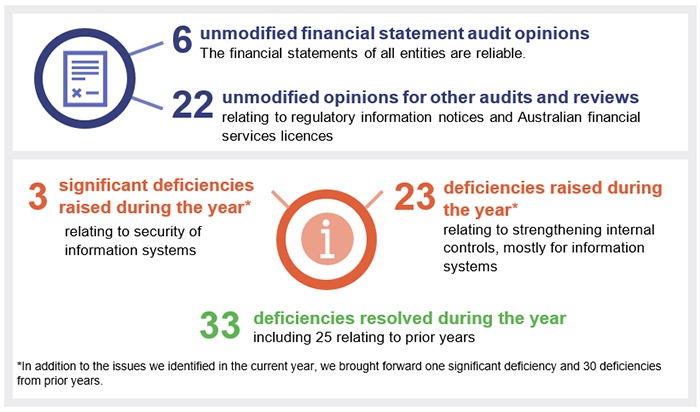
Notes:
- Regulatory information notices are used to collect information from the distribution entities to assist the Australian Energy Regulator (AER) in deciding how much these entities can earn.
- Entities must have Australian financial services licences if they enter into fixed-price contracts to manage the future risk of fluctuating electricity prices. These entities must lodge an annual compliance form with the Australian Securities and Investments Commission.
Financial statements and other reports are reliable
We issued unmodified audit opinions on the financial statements of all 6 energy entities in Queensland. This means their financial statements have been prepared in accordance with the relevant legislative requirements and Australian accounting standards, and their results can be relied on.
In the current year, some of the entities experienced disruptions in their financial statement preparation processes due to the impacts of COVID-19 and complexities caused by volatility in the energy market. Despite these challenges, all energy entities met their legislative deadlines for signing their financial statements.
Appendix D details the audit opinions we issued for energy entities in 2021–22. Appendix E lists the entities that are not required to prepare financial statements and the reasons why.
Other audit certifications
Appendix D also lists the assurances we performed during the year on regulatory information notices and Australian financial services licences.
For the regulatory information notices, if the information is based on actual data, we conduct an audit. If it is based on estimated data, we conduct a review. We have issued 6 unmodified audit opinions and 12 unmodified review conclusions for these audits.
The entities fulfilled their obligations under their financial services licenses during the year.
Entities should continue strengthening their internal controls
We assess whether the internal controls entities use to prepare financial statements are reliable, and report any weaknesses in their design or operation to management for action. We rate these weaknesses as either significant deficiencies (higher risk that require immediate action by management) or deficiencies (lower risk that can be corrected over time). Figure 2A summarises the internal control issues in the current (2021–22) and prior years (from 2018–21).
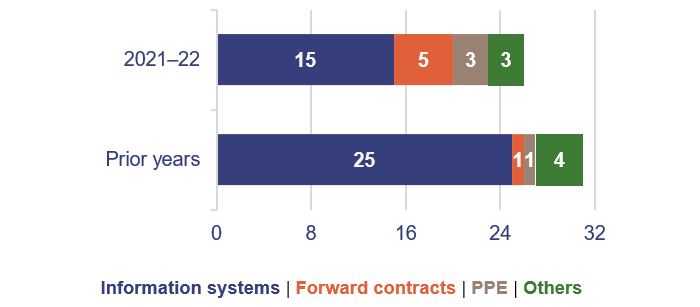
|
We continued to identify significant deficiencies relating to information systems. These accounted for most of our findings and continue to be an area of focus for our audits. The volatility in the energy market resulted in errors in the calculation of forward electricity contract values. We also identified deficiencies relating to payroll; expenses; revenue; and property, plant and equipment (PPE) processes. These deficiencies occurred due to upgrades in information systems, changes in internal processes and controls, and turnover in the people managing those controls. |
Compiled by the Queensland Audit Office.
Our most common finding across all energy entities relates to weaknesses in the controls of user access in information systems, which has been an ongoing issue across a range of sectors. Energy entities need to conduct regular monitoring of the internal controls over access to these systems.
As cyber security threats increase in number and sophistication, it is critical that entities promptly address any weaknesses in their information systems. Entities should continue implementing controls to maintain and strengthen the security of their information systems.
As part of our audits, we monitor how entities resolve the weaknesses we have identified. In 2021–22, entities resolved a significant number of prior year and current year deficiencies.
The open issues mainly relate to information systems, which entities expect to resolve within the next 12 months as they refine their controls in new systems, and as new systems come online.
We recommend all entities continue to act on the recommendation from our Energy 2021 report to strengthen the security of their information systems. Appendix C provides the full recommendation and status at 30 June 2022.
Energy entities are upgrading their information systems
The energy entities continue to upgrade their information systems. In 2021–22, Powerlink implemented its new information system within its approved budget.
Energy Queensland, however, continues to experience delays in implementing the final components of its digital technology program. When the implementation began in December 2017, the planned completion date was June 2020. While various key components of the program have been delivered, full implementation has been delayed. This is because of:
- changes in the scope of the project
- the complexity in integrating multiple systems
- skill shortages
- the impacts of COVID-19
- challenges with implementation partners and vendors.
The approved budget has been increased to $717 million. Energy Queensland is currently negotiating additional budget to cover for the delays. Any further increases will affect the cost savings the new system is expected to generate.
The Australian Energy Regulator (AER) plays a part in this. While the AER does not specify what distribution entities are allowed to spend on specific items (such as digital technology programs), it does set the amount of capital expenditure the entities can recover from their customers. To the extent that Energy Queensland cannot meet the extra costs through savings in other areas, the AER will determine how much will be funded by customers and by Energy Queensland’s shareholders (the Queensland Government).
CS Energy had a cyber security incident
In 2020–21, the Australian Cyber Security Centre reported that about a quarter of reported cyber security incidents affected entities associated with Australia’s critical infrastructure.
This year, CS Energy was subject to a cyber attack that disabled its corporate network. CS Energy enacted its business continuity plan and successfully restored its corporate network. Its power stations were not impacted by the cyber incident and continued to safely generate and dispatch electricity to the National Electricity Market. As a result, the incident did not have a material impact on the financial performance of the business.
When the business continuity plan was in place, the entity accounted for its financial transactions manually, and subsequently transferred these transactions to the restored finance system.
Accordingly, we extended our audit approach to confirm the completeness and accuracy of financial data following the manual recording of the financial transactions. We included this as a key audit matter (an area with higher risk of material misstatement) in our audit opinion.
Our procedures for addressing this risk included:
- reviewing the reports of external experts who supported management in dealing with the incident
- reviewing board minutes and cyber security steering committee minutes to understand the impact of the incident on the business and the recovery process
- validating the completeness and accuracy of balances in the finance system, once it was restored.
In 2022–23, we plan to complete an audit on responding to and recovering from cyber attacks, which will provide insights into, and lessons learned from, entities’ preparedness for these attacks.

3. Financial performance of energy sector entities
This chapter analyses the key financial results and challenges faced by the energy sector.
Chapter snapshot
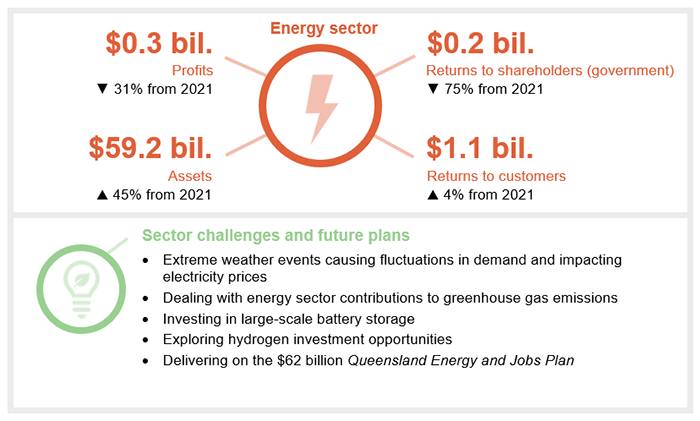
There has been a significant decrease in the sector’s profits due to price volatility in the energy market
In 2021–22, the energy entities recorded a total profit of $332.2 million, which is a decrease of $146.7 million (31 per cent) from the previous year.
Figure 3A outlines the performance results of state-owned energy entities – generators, transmitters, distributors and retailers.
|
The decrease has largely been due to the impact of market volatility on the profits of the generation entities (CleanCo, CS Energy, and Stanwell). To achieve revenue certainty in a volatile wholesale electricity market, the generators enter into contracts that lock in a fixed price for the electricity they will sell in the future. Generators recorded losses due to the rise in wholesale electricity prices above the fixed contract prices. This contributed to the generators recording a total loss of $244.8 million in 2021–22. The rest of the sector recorded an increase in profits of $188.1 million from 2020–21. |
Compiled by the Queensland Audit Office from energy entities’ financial statements.
Significant market volatility has resulted in high electricity prices across the National Electricity Market
While future electricity prices were forecast to decrease, unplanned volatility in the energy market during the year resulted in energy prices increasing across the National Electricity Market (NEM). This is the wholesale electricity market where generators and retailers from the eastern and southern Australian states and territories trade electricity.
Figure 3B shows the increase in the wholesale electricity prices in Queensland and across the other NEM regions.
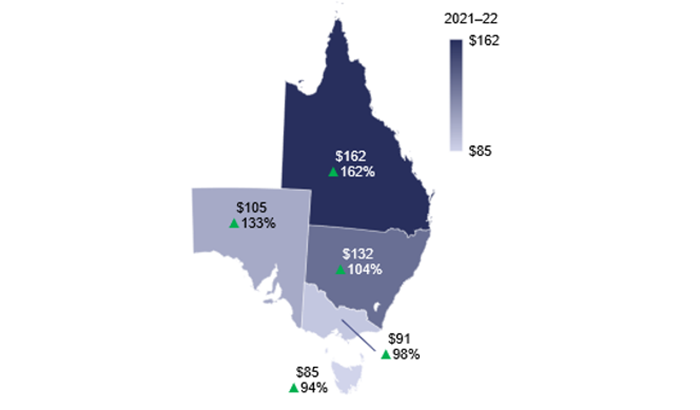
|
In 2021–22, wholesale electricity prices across the NEM increased by 118 per cent on average compared to those reported in 2020–21. Queensland recorded the highest movement and average wholesale electricity price in the current financial year of $162 per MWh (it was $62 in 2020–21). The increase in Queensland’s wholesale price was due to greater volatility experienced in the second half of the year as outlined in Figure 3C. Two years ago, Queensland’s wholesale electricity price was $53 per MWh, the lowest of all regions in the NEM. |
Notes:
- MWh – a megawatt hour, which is equal to 1,000 kilowatts of energy used continuously for one hour.
- Wholesale electricity prices are one component of retail electricity prices (with the other components being network and retail costs).
- Refer to Appendix G – Figure G1 for further details.
Compiled by the Queensland Audit Office from Australian Energy Market Operator pricing data extracted on 6 December 2022.
Figure 3C outlines the increase in price volatility experienced in Queensland wholesale electricity prices in 2021–22. This was due to a combination of the following factors:
| High prices for gas and coal, which are driven by a number of global factors including the Ukraine conflict, increased the cost of producing energy. | |
| Planned and unplanned coal-fired power station outages across the NEM, including Callide C and Swanbank, reduced available supply. | |
| Heavy rainfall, heatwaves, and a cooler winter led to higher demand for electricity and lower output from renewable energy sources. | |
| A transmission lines outage caused by upgrades to the Queensland–New South Wales Interconnector reduced the transfers of electricity from the NEM into Queensland to meet increased demand. |
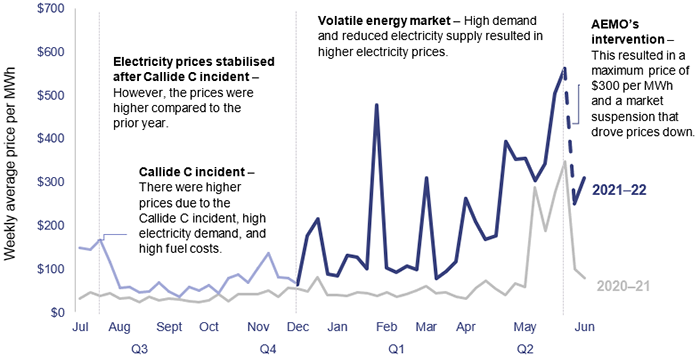
Notes:
- An incident at Callide C in May 2021 resulted in a generation unit being withdrawn from the market. This contributed to higher prices until mid-July 2021.
- Intervention of the Australian Energy Market Operator (AEMO) – The price cap of $300 per MWh caused some generators to withdraw their supply of electricity to the market due to higher generation costs. Consequently, AEMO intervened by suspending the market for 9 days and directly scheduling generation across the NEM to ensure secure and reliable supply of electricity.
Compiled by the Queensland Audit Office from AEMO weekly pricing data extracted on 6 December 2022.
Increasing wholesale prices affect the generators’ ability to profit from forward electricity contracts
Generators and retailers manage fluctuations in wholesale electricity prices by entering into contracts with each other. They negotiate and lock in a fixed price for electricity they will sell (the generators) and buy (the retailers) in the future. These are called forward electricity contracts, which are traded over the counter (direct contracts between 2 parties) or on the Australian Securities Exchange.
Sale prices in contracts were locked in at lower forward electricity prices than what the actual market price turned out to be. These movements are recognised as unrealised losses as at the financial reporting date. They will only be realised at a future date either as a gain or loss when the electricity is delivered and the contracts are settled, which will be based on the electricity price at that time. As at 30 June 2022, the unfavourable price movements in the contracts held by the generators contributed to operating losses amounting to $868 million (they had a $5.5 million operating gain in 2020–21). For the generators to maintain adequate cash to cover these losses, they obtained additional funding from Queensland Treasury Corporation.
In contrast, retailers such as Ergon Energy Queensland were able to benefit by being on the other side of the forward electricity contract. During the year, movements in the energy market price resulted in a $517.7 million gain ($52.5 million in 2020–21), which contributed significantly to the overall profit for Ergon Energy Queensland.
Returns to shareholders have decreased
Returns to shareholders are made up of dividends (a share of profits paid to shareholders) and income tax equivalents (which are taxes payable by commercial operators in government).
Total returns to the state government amounted to $214 million, a decrease of $647 million (75 per cent) from the previous year. Figure 3D shows the decline in returns to shareholders from 2020–21 to 2021–22.
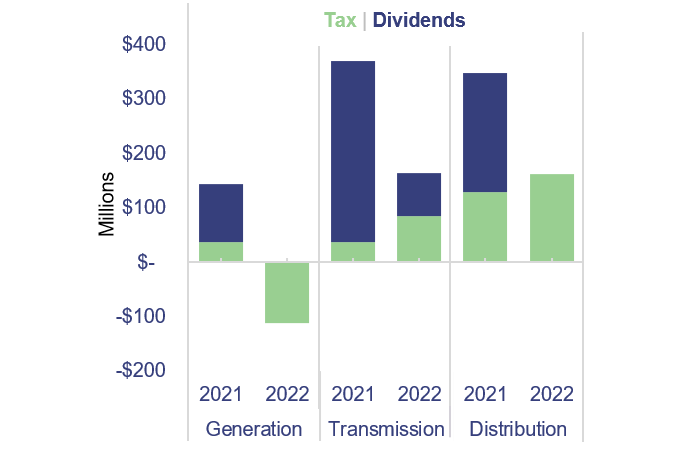
|
In November 2021, Powerlink (a transmission entity) paid a special dividend of $80 million for 2021–22, which is consistent with the payments made in prior years. In June 2022, the state government approved the government owned energy corporations to retain their dividends for 2021–22. This was to support investment in their critical infrastructure and grow their businesses. The income tax equivalents payable to the shareholders are based on taxable profits or losses. Generators incurred losses, which were driven by CleanCo's and CS Energy’s results in 2021–22. A loss may result in a benefit through a reduction in future tax payments or tax refund. |
Compiled by the Queensland Audit Office from Queensland public sector entities’ certified financial statements.
Returns to customers have increased
Total returns to customers amounted to $1.1 billion in 2021–22, an increase of $39 million (4 per cent) from 2020–21. Figure 3E shows the returns to customers from 2019–20 to 2021–22.

|
Community service obligation payments (CSO) were made to Energy Queensland to support regional customers by subsidising the high costs of providing electricity to regional Queensland. However, a reduction in retail tariff prices was offset by an increase in the cost to purchase electricity, so CSO payments to Energy Queensland increased by $71 million compared to 2020–21. Without these payments, Ergon Energy Queensland would have recorded a loss after tax of $297 million in 2021–22. The Affordable Energy Plan includes the $50 electricity bill credit to customers and COVID-19 utility relief payments. The COVID-19 relief payments provided to households and eligible small businesses in 2019–20 were not extended. In response to the higher cost of living caused by increasing electricity prices, the state government will be providing a $175 Cost of Living Rebate to household electricity bills from September 2022. |
Note: The Solar Bonus Scheme relates to payments made by Energy Queensland to customers for the power they contributed to the energy grid through their rooftop solar. The scheme has closed for new applicants and will cease for existing eligible customers on 1 July 2028. Other electricity rebates and concessions mostly consist of payments made to eligible pensioners and seniors.
Compiled by the Queensland Audit Office from Queensland public sector entities’ certified financial statements.
The energy sector faces future challenges
Recent heatwaves and cold weather snaps experienced in Queensland led to higher demand for electricity and placed upward pressure on electricity prices.
Coal, gas, and oil are major sources of greenhouse gas emissions. The Queensland Government is taking steps to cut greenhouse gas emissions. Figure 3F shows the declining emissions by state-owned power stations in Queensland.
The energy sector contributes to greenhouse gas emissions
The state-owned generators – Stanwell and CS Energy – operate coal-fired power stations, which delivered the majority of Queensland’s electricity in 2021–22. Based on the Clean Energy Regulator’s national greenhouse and energy reporting data, they are among the top 5 emitters in Australia.
|
Emissions are declining, but the rate of decline depends on the amount of electricity generated, the quality of coal, and the condition of power station maintenance. CS Energy and Stanwell continue to invest in renewable energy sources and battery storage to offset their emissions and reduce the impact their operations have on the environment. |
Notes:
- 2021–22 emissions data has yet to be submitted to the Clean Energy Regulator (the government body responsible for accelerating the reduction of carbon).
- CO2-e is a measure used to compare the emissions from various greenhouse gases by converting them to the equivalent amount of carbon dioxide.
Compiled by the Queensland Audit Office from data submitted by the generators to the Clean Energy Regulator.
As Queensland energy entities become more reliant on renewable energy sources, it is essential that they continue to deliver reliable and affordable electricity. Investments in battery and pumped hydro storage can complement the intermittent output of the renewable energy sources, and stabilise the power grid.
Pumped hydro storage stores energy. It uses 2 water reservoirs at different elevations to generate power as water moves down through a turbine from one to the other. It acts like a giant battery, storing power during the day and releasing it in peak periods or when needed.
Figure 3G shows the decreasing proportion of coal in Queensland’s generation profile. Over time, the proportion of energy from renewable energy and storage will increase with the reduction in coal-fired generation.
|
The share of electricity generated from coal has decreased by 8,969 GWh (12 per cent) over the past 5 years and in 2021–22 accounted for 72 per cent of energy generated. The reduction in the reliance on coal is driven by the increasing penetration of renewable energy into the market and outages from coal-fired plants. The contribution generated from gas has remained relatively stable |
Notes:
- GWh – a gigawatt hour, which is equal to 1,000 megawatts of energy used continuously for one hour.
- The percentages do not include generation from small-scale generators with capacity of less than 30 MW.
Compiled by the Queensland Audit Office from AEMO and OpenNEM generation data.
Queensland has committed to reaching 70 per cent renewable energy by 2032
On 28 September 2022, the Queensland Government announced the Queensland Energy and Jobs Plan, which aims to address some of the challenges faced by the energy sector. Figure 3H sets out the plan’s main commitments.

Compiled by the Queensland Audit Office from the Queensland Energy and Jobs Plan.
Under the Queensland Energy and Jobs Plan (the Plan), all state-owned coal-fired power stations will progressively be converted to green energy sources by 2035 to meet the state’s renewable energy targets. They will be used for back-up capacity until new pumped hydro is operational and reliable.
Currently, coal-fired power stations with a generation capacity of 4,465 megawatts (86 per cent of existing state-owned generation capacity) are scheduled for retirement after 2035. The plan does not yet detail how the coal-fired power stations will be converted to green energy sources and the impact on the planned retirement dates.
In 2021–22, the Queensland energy entities announced additional investments in renewable energy projects that include battery storage, power purchase agreements with solar and wind farms, and partnerships with private investors to start feasibility studies for hydrogen projects. These projects were not specifically referenced in the Plan, but they will contribute to achieving the targets for renewable energy and emissions reduction set out in it.
In addition, in August 2022, the state government announced a new entity – Queensland Hydro – that will develop pumped hydro energy storage assets in Pioneer–Burdekin (Mackay–Isaac–Whitsunday region) and Borumba (Wide Bay–Burnett region).
Project assessment and some early works for the new green energy projects will start in 2023. Effective planning is essential for large infrastructure projects. They can be affected by a number of factors, including shortages in skilled labour, increased material costs, and delays in obtaining construction materials. This can mean the projects may not be delivered within approved budgets and target timelines.
In planning for large-scale infrastructure projects as outlined in the Plan, the entities involved will need to comply with relevant government frameworks, such as Queensland Treasury’s Project Assessment Framework, for investment proposals and business case development. Compliance with these frameworks will ensure the commercial viability of the projects is appropriately assessed, and that project objectives and benefits are clearly articulated and measured.

2022 energy dashboard
This Queensland Audit Office interactive map of Queensland allows you to explore information on energy entities for 2022 and compare to other regions. You can find information on energy in Queensland by typing your address into the search bar or clicking on your local region or an entity.
